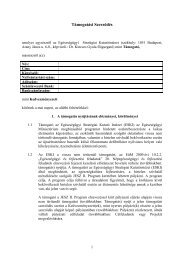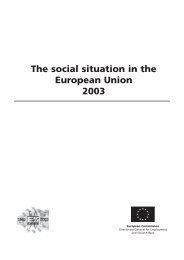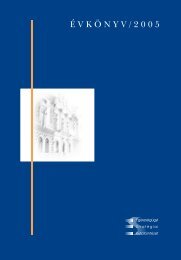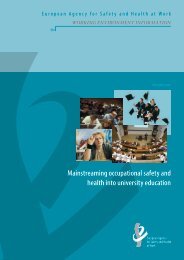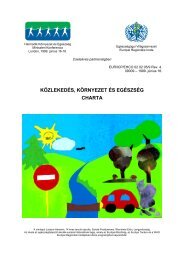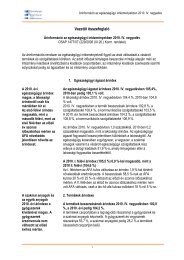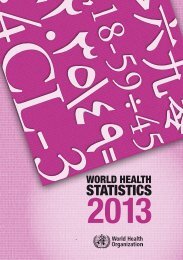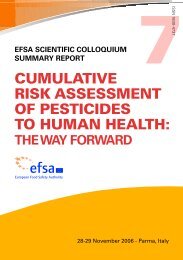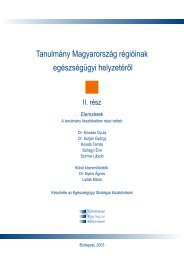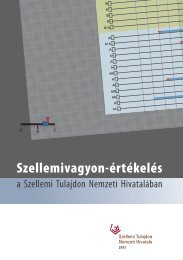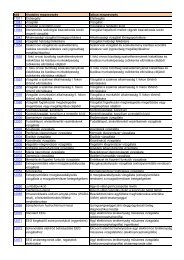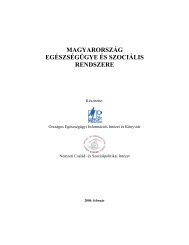Systematic review and evidence- based guidance ... - ECDC - Europa
Systematic review and evidence- based guidance ... - ECDC - Europa
Systematic review and evidence- based guidance ... - ECDC - Europa
You also want an ePaper? Increase the reach of your titles
YUMPU automatically turns print PDFs into web optimized ePapers that Google loves.
<strong>Systematic</strong> <strong>review</strong> <strong>and</strong> <strong>evidence</strong>-<strong>based</strong> <strong>guidance</strong> on perioperative antibiotic prophylaxisTECHNICAL REPORTFigure 4. Summary of the experts’ recommendation to proposed PAP modalitiesStrongly recommend Recommend Neither recommend nor disagree No recommendation Strongly no recommendationForming a multidisciplinary AM team <strong>and</strong> establishing a PAP protocolAM team should perform an audit <strong>and</strong> structured feedback for OR staffStop of PAP administration < 24 hours post surgeryAdministration of PAP by anaesthesiologistSingle dose of PAP should be preferred over multiple dosesRevision of PAP protocol/guidelines by the AM teamAdministration of PAP 30 to 60 minutes before incisionRegular education of OR staff about adequate PAPPeriodical surveillance of data on multidrug-resistant bacteriaYearly audits <strong>and</strong> feedback for OR staffAdministration of PAP within 30 minutes before incisionAdjustment of PAP dosage according to patient's weightImplementation of reminder system (i.e. computer <strong>based</strong>, checklist or time-out)Implementation of computer-assisted automatic stop order of PAPPre-operative screening of patients for multidrug-resistant bacteria0% 20% 40% 60% 80% 100%Table 19. PAP modalities as outlined at the first expert meeting10 modalities of perioperative antibiotic prophylaxis1 A multidisciplinary AM team (including surgeons, anaesthesiologists, nurses, pharmacists, infection control specialists, <strong>and</strong>clinical microbiologists) should develop <strong>and</strong> implement a protocol of appropriate PAP.2 A multidisciplinary AM team should regularly update the PAP protocol according to st<strong>and</strong>ard, approved guidelines.3 To control the appropriate selection of antibiotics, as well as timing <strong>and</strong> duration of prophylaxis, a multidisciplinary AM teamshould perform an audit of surgeons, anaesthesiologists <strong>and</strong> OR nursing staff <strong>and</strong> provide, if necessary, structured feedback<strong>and</strong> education to healthcare staff <strong>and</strong> decision-makers.4 In order to encourage appropriate duration <strong>and</strong> dosage of PAP, a computer-assisted decision support system <strong>and</strong> automaticreminder system should be implemented.5 PAP should be the responsibility of the anaesthesiologist.6 PAP should be administered within 30–60 minutes before incision (except for vancomycin <strong>and</strong> fluoroquinolones), ideally at thetime of anaesthetic induction.7 Although a single dose of PAP is preferred, subsequent doses should be given depending on the duration of the procedure<strong>and</strong> the half-life of the antibiotic, <strong>and</strong> if significant blood loss occurs during surgery.8 Prolonging prophylaxis after the end of surgery is not recommended.9 The PAP protocol should take into account individual patient factors like BMI, underlying diseases, or colonisation withresistant pathogens.10 In surgical departments, patterns of MDROs <strong>and</strong> incidence of Clostridium difficile infections should be monitored proactively soPAP can be appropriately adjusted.3.2.2 Second expert meeting, Berlin, GermanyBefore the second meeting in Berlin, the experts agreed to re-score the 10 modalities by evaluating the quality <strong>and</strong>strength of <strong>evidence</strong> <strong>and</strong> implementability, this time using a 6-point scale ranging from 1 (strongly disagree) to 6(strongly agree) in order to facilitate the ranking process (Table 20).28



